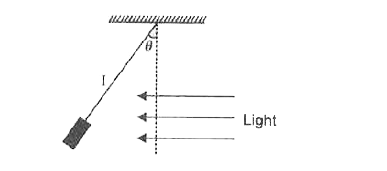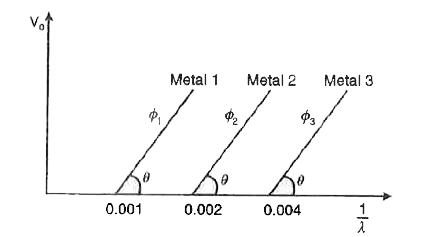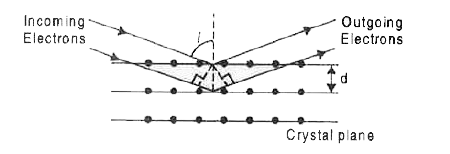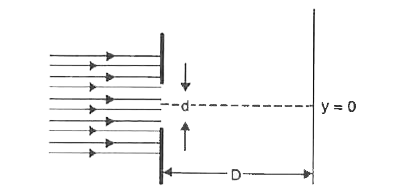Complete Solutions to MULTIPLE CHOICE QUESTIONS (LEVEL-II) of chapter ELECTRONS & PHOTONS of Class 12 book with complete answers and questions
| Class 12 | PHYSICS |
| Chapter | ELECTRONS & PHOTONS |
| MODERN PUBLICATION | MULTIPLE CHOICE QUESTIONS (LEVEL-II) |
| Number Of Questions | 63 |
| Academic Year | 2023-24 |
Maximum frequency of the photon produced by the union of a proton and a antiproton is (given : `m_(p)=1.67xx10^(-27)kg`):
View SolutionIf the frequency of incident light on a certain metal is `8.2xx10^(14)Hz`, having threshold frequency `3.3xx10^(14)Hz`, then cut off potential is :
View SolutionThreshold wavelength for metal is `10,000Å`. If light of wavelength `5461Å` is incident on it, then stopping potential is 1.02 V, then value of Planck's constant is :
View SolutionAn electron moving with a speed of `10^(7)ms^(-1)` traces a circular path of radius 0-57 cm, when subjected to a magnetic field of `10^(-2)` T perpendicular to the direction of motion of electron, what is elm ?
View SolutionAn electron beam passes through a magnetic field of `2xx10^(-3)` T and electric field of `3xx10^(-4)` V/m at right angles to it. Its specific charge is `1.75xx10^(11)C//kg^(-1)`. What is the radius of the path in which it is deflected, if there is no deflection, when both fields are acting ?
View SolutionA proton, a deuteron and an a-particle have same kinetic energies. Their velocities are in the ratio of:
View SolutionA stream of electrons moving with `3xx10^(7)ms^(-1)` gets deflected by electric field of 18 V/ cm normal to their path. What is its transverse deflection in travelling through a horizontal distance of 10 cm in the field ? `(m_(e)=9xx10^(-31)kg)`:
View SolutionIn a Thomson's set up for elm, the same high tension d.c. supply provides potential to anode for acceleration and also the positive voltage to the deflecting plate in the region of crossed fields. If the supply voltage is doubled, by what factor the magnetic field be increased to keep the electron beam undeflected ?
View SolutionThe increasing order of the specific charge on (i) electron (e) (ii) proton (p) (iii) neutron (n) and (iv) O-particle (a) is :
View SolutionDoubly ionised helium atoms and hydrogen ions are final velocities of helium and of the hydrogen ions is :
View SolutionIn Bainbridge's mass spectroscope the singly ionised ion of `N_(e)^(20)` strike the photographic plate at a distance of 20 cm from the slit. Then the distance at which singly ionised ions of `N_(e)^(22)` strike the photographic plate is :
View Solution`H^(+),He^(+)` and `O^(++)` all having same kinetic energy while they pass through a region in which there is a uniform magnetic field perpendicular to their velocities. The masses of `H^(+),He^(+)` and `O^(++)` are 1, 4 and 16 a.m.u respectively then,
View SolutionThe ratio of momenta of an electron and an alpha particle which are accelerated from rest through a potential difference of 100 volts is :
View SolutionA cyclotron is operating at a frequency of `12xx10^(6)Hz`. Mass of deuteron is `3.3xx10^(-27)` kg and its charge is `1.6xx10^(-19)` C. To accelerate the deuterons, the magnetic induction of the field required is :
View SolutionA charged oil drop is held stationary in an electric field. The space containing the drop is exposed to a radioactive source and drop moves with different terminal velocities v, 2v, 30, 40 ....... etc. It suggests :
View SolutionIn an electron microscope, if the potential is increased from 20 kV to 80 kV, the resolving power R of the microscope will become :
View SolutionThe total energy of `H_(2)` atom, when the electron is in the second quantum state is `E_(2)`. The total energy of `He^(+)` ion in the third quantum state is :
View SolutionThe wavelength of `K_(alpha)` line from an element of atomic number 41 is `lamda`. Then the wavelength of `K_(alpha)` line of an element of atomic number 21 is :
View SolutionIn an experiment of photoelectric emission for incident light of `4000Å`, the stopping potential is 2V. If the wavelength of incident light is made `3000Å`, then stopping potential will be :
View SolutionIn Davisson-Germer experiment, an electron beam of energy 60 eV is incident normally on a crystal surface. The maximum intensity is obtained at an angle of `60^(@)` from the direction of incident beam, then the inter atomic distance in the crystal lattice will be :
View SolutionIn an X-rays tube, if the electrons are accelerated through 140 KV, then anode current obtained is 30 mA. If the whole energy of electrons is converted into heat, then the rate of production of heat at anode will be :
View SolutionWhen X-rays of wavelength `0-5Å` pass through 7 mm thick aluminium sheet, then their intensity reduces to one fourth. The coefficient of absorption of aluminium for these X-rays will be :
View SolutionThe kinetic energies of the photoelectrons are `E_(1)` and `E_(2)` with wavelength of incident light `lamda_(1)` and `lamda_(2)`. The work function of the metal is :
View SolutionThe K.E. of the electron is E, when the incident wavelength is `lamda`. To increase the K.E. of the electron to 2E, the incident wavelength must be :
View Solution`K_(alpha)` radiation of Mo (Z = 42) has a wavelength of `0.71Å`. Calculate wavelength of the corresponding radiation of Cu (Z=29)
View SolutionA long solenoid of 20 turns/ cm carries a current of 1.0 A. Radiation of wavelength `lamda` fall on a target placed within the solenoid. It is observed that electrons emitted move in a circle of largest radius 1 cm. Find the value of `lamda`. Given work function is 1 eV:
View SolutionRadiation of wavelength 180 nm eject photoelectrons from a plate whose work function is 2.0 eV. If a uniform magnetic field of flux density `5.0xx10^(-5)T` is applied parallel to plate, what should be the radius of the path followed by electrons ejected normally from the plate with maximum energy:
View SolutionA potassium surface is placed 75 cm away from a 100 W bulb. It is found that energy radiated by the bulb is 5% of the input power. Consider each potassium atom as a circular disc of diameter `1Å` and determine the time required for each atom to absorb an amount of energy equal to its work function of 2:0 eV:
View SolutionFor a particle of mass m enclosed in a one-dimentional box of length L, the de-Broglie concept would lead to stationary waves, with nodes at the two ends. The energy values allowed for such a system (with n as integers) will be:
View SolutionTwo beams P and Q of light of the same wavelength fall upon the same metal surface causing photoemission of electrons. The photoelectric current produced by P is four times that produced by Q. Which of the following gives the ratio
`("wave amplitude of beam P")/("wave amplitude of beam Q")`?
View SolutionLight of wavelength `5000Å` and intensity `39.8Wm^(-1)` is incident on a metal surface. If only 1% photons of incident light emit photoelectrons, then the number of electrons emitted per second per unit area from the surface will be nearly :
View SolutionThe distance between two consecutive atoms of the crystal lattice is `1.227Å`. The maximum order of diffraction of electrons accelerated through `10^(4)` volt is :
View SolutionIf the momentum of electron is changed by `p_(m)` then the de-Broglie wavelength associated with it changes by 0.50%. The initial momentum of electron will be :
View SolutionA 20 a.m.u. atom emits photon of `6.6Å` while making a transition from excited state to ground state. The recoil energy of the atom will be :
View SolutionIn a photoelectric set up, a point source of light of power `3.2xx10^(-3)` W emits monoenergetic photons of energy 5.0 eV. The source is located at a distance of 0.8 m from the centre of a stationary metallic sphere of work function 3.0 eV and of radius `8.0xx10^(-3)` m. The efficiency of photoelectron emission is one for every `10^(6)` incident photon. Assume that state is isolated and initially neutral and that the photoelectrons are instantly swept away after emission. Calculate the number of photoelectron emitted per sec, by sphere :
View SolutionIn Ques, 126, ratio of the wavelength of incident light to the de-Broglie wavelength of the fastest electron emitted is :
View SolutionA light source emitting three wavelength `5000Å, 6000Å, 7000Å` has a total power of `10^(-3)` m. W and the beam of diameter `2xx10^(-3)`m. The power density is distributed equally amongst the three wavelengths. The beam shines normally on a metallic surface of area `10^(4)m^(2)` which has a work function of 1.9 eV. Assuming that each proton liberates an electron, calculate the charge emitted per unit area in one second :
View SolutionRadiation of wavelength 180 nm eject photoelectrons from a plate whose work function is 2.0 eV. If a uniform magnetic field of flux density `5.0xx10^(-5)T` is applied parallel to plate, what should be the radius of the path followed by electrons ejected normally from the plate with maximum energy:
View SolutionOne milliwatt of light of wavelength `4560Å` is incident on a cesium surface. Calculate the photoelectric current liberated, assuming a quantum efficiency of 0.5%. Given work function for cesium = 1.93 eV :
View SolutionA cylindrical rod of some laser material `5xx10^(-2)m` long and `10^(-2)m` diameter contains `2xx1025^(25)` ions per `m^(3)`. If on excitation all the ions in the upper energy level de-excite simultaneously emitting photons in the same direction, calculate the maximum energy contained in a pulse of radiation of wavelength `6.6xx10^(-7)m`
View SolutionIn Ques. 131, if the pulse lasts for `10^(-7)` sec, calculate average power of the laser during the pulse :
View SolutionFig. shows a small plane strip suspended from a fixed support through a string of length 1. A continuous beam of monochromatic light is incident horizontally on the strip and is completely absorbed. The energy falling on the strip per unit area per sec is P. The deflection of the string from the vertical, if the strip stays in equilibrium.

View SolutionIn Q. 133, if the strip is deflected slightly from its equilibrium position in the plane of the figure, the time period of the resulting oscillation is given by :
View SolutionThe radiation emitted when an electron jumps from n=3 to n = 2 orbit in a hydrogen atom, falls on a metal to produce photoelectron. The electron with maximum kinetic energy are made to move perpendicular to a magnetic field of `(1)/(320)` T in a radius of `10^(m)`. The work function of the metal is :
View SolutionA monochromatic light source of frequency villuminates a metallic surface and ejects photoelectron. The electron with maximum energy are just able to ionize the hydrogen atom in the ground state. When the whole experiment is repeated with an incident radiation of frequency 5/6 v, the photoelectrons so emitted are able to excite the hydrogen atom beam which then emits a radiation of the wavelength `1215Å`. Find the work function of the metal :
View SolutionIn Ques, 136, the frequency v of the source is :
View SolutionLet `n_(r)` and `n_(b)` be respectively the number of photons emitted by a red bulb and a blue bulb of equal power in a given time. Then :
View SolutionFor a particle of mass m enclosed in a one-dimentional box of length L, the de-Broglie concept would lead to stationary waves, with nodes at the two ends. The energy values allowed for such a system (with n as integers) will be:
View SolutionAn electron accelerated under a potential difference V volt has a certain wavelength `lamda`. Mass of the proton is 2000 times the mass of the electron. If the proton has to have the same wavelength `lamda`, then it will have to be accelerated under a potential difference of:
View SolutionIn Davisson-Germer experiment, the correct relation between angle of diffraction and glancing angle is :
View SolutionThe potential difference applied to an X-ray tube is 5kV and current is 3.2 mA. Then no. of electrons striking the target per sec is :
View SolutionThe work function of a substance is 4.0 eV. The longest wavelength of light that can cause photoelectric emission for it will be :
View SolutionA charged oil drop is suspended in a uniform field of `3xx10^(4)` V/m so that it neither falls nor rises. The charge on drop will be (Take mass of charge `=9.9 X10^(-15)kg` and `g=10m//s^(2)`).
View SolutionFig. shows variation of photocurrent with anode potential for photosensitive surface for three different radiations. Let `I_(a), I_(b)` and `I_(c)` be the intensities and `f_(a),f_(b)` and `f_(c)` the frequencies for curves a, b to c, then:

View SolutionAn element with Z = 11 emits `Kalpha`-X-ray with wavelength `lamda`. The atomic no. of element which emits `Kalpha` X-ray of wavelength `4lamda` is:
View SolutionThe wavelength of `K_(alpha)` line of an X-ray spectrum of an element of atomic no. Z= 11 is `lamda`.. The wavelength of same line of element of atomic no. Z' is `4lamda`, then Z' is :
View SolutionThe graph between the stopping potential `(V_(0))` and wave number `(1//lamda)` is as shown in the figure.

`phi` is the work function, then:
View SolutionElectrons with de-Broglie wavelength `lamda` fall on the target in an X-ray tube. The cut-off wavelength of the emitted X-rays is:
View SolutionDirection : Question Numbers. 150 and 151 are based on the following paragraph.
Wave property of electrons implies that they will show diffraction effects. Davisson and Germer demonstrated this by diffracting electrons from crystals. The law governing the diffraction from a crystal is obtained by requiring that electron waves reflected from the planes of atoms in a crystal interfere constructively (See figure).

Electrons accelerate by potential V are diffracted from a crystal. If `d=1Å` and `i=30^(@)`, V should be about `(h=6.6xx10^(-34)Js,m_(e)=9.1xx10^(-31)kg,e=1.6xx10^(-19)C)`
View SolutionDirection : Question Numbers. 150 and 151 are based on the following paragraph.
Wave property of electrons implies that they will show diffraction effects. Davisson and Germer demonstrated this by diffracting electrons from crystals. The law governing the diffraction from a crystal is obtained by requiring that electron waves reflected from the planes of atoms in a crystal interfere constructively (See figure).

If a strong diffraction peak is observed when electrons are incident at an angle i from the normal to the crystal planes with distance d between them (see tigure), de-Broglie wavelength `lamda_(dB)` of electrons can be calculated by the relationship (n is an integer)
View SolutionIn an experiment, electrons are made to pass through a narrow slit of width d comparable to their de-Brogile wavelength. They are detected on a screen at a distance D from the slit.

Which of the following graphs can be expected to represent the number of electrons N detected as a function of the detector position y(y = 0 corresponds to the middle of the slit)?
View SolutionThe surface of a metal is illuminated with the light of 400 nm. The kinectic energy of the ejected photoelectrons was found to be 1.68 eV. The work function of the metal is (hc = 1240 eV nm)
View SolutionPhotoelectric effect experiments are performed using three different metal plates p, and r having work functions `phi_(P)=2.0eV,phi_(q)=2.5eV` and wavelengths of 550 nm, 450 nm and 350 nm with equal intensities illuminates each of the plates. The correct I-V graph for the experiment is (Take hc = 1240 eV nm)
View Solution
MULTIPLE CHOICE QUESTIONS (LEVEL-II) questions and complete solutions for chapter ELECTRONS & PHOTONS of MODERN PUBLICATION PHYSICS (KANNADA ENGLISH) of Class 12